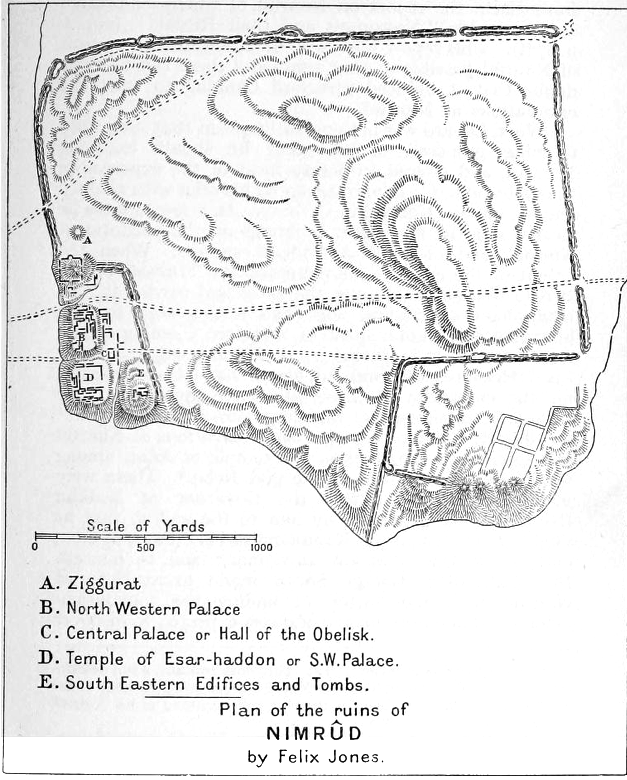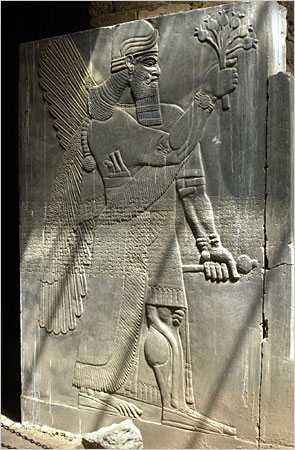|
Calah
Nimrud (; syr, ܢܢܡܪܕ ar, النمرود) is an ancient Assyrian city located in Iraq, south of the city of Mosul, and south of the village of Selamiyah ( ar, السلامية), in the Nineveh Plains in Upper Mesopotamia. It was a major Assyrian city between approximately 1350 BC and 610 BC. The city is located in a strategic position north of the point that the river Tigris meets its tributary the Great Zab.Brill's Encyclopedia of Islam 1913-36 p.923 The city covered an area of . The ruins of the city were found within of the modern-day village of |
Kalhu
Nimrud (; syr, ܢܢܡܪܕ ar, النمرود) is an ancient Assyrian city located in Iraq, south of the city of Mosul, and south of the village of Selamiyah ( ar, السلامية), in the Nineveh Plains in Upper Mesopotamia. It was a major Assyrian city between approximately 1350 BC and 610 BC. The city is located in a strategic position north of the point that the river Tigris meets its tributary the Great Zab.Brill's Encyclopedia of Islam 1913-36 p.923 The city covered an area of . The ruins of the city were found within of the modern-day village of |
Nimrud Plan 1920
Nimrud (; syr, ܢܢܡܪܕ ar, النمرود) is an ancient Assyrian city located in Iraq, south of the city of Mosul, and south of the village of Selamiyah ( ar, السلامية), in the Nineveh Plains in Upper Mesopotamia. It was a major Assyrian city between approximately 1350 BC and 610 BC. The city is located in a strategic position north of the point that the river Tigris meets its tributary the Great Zab.Brill's Encyclopedia of Islam 1913-36 p.923 The city covered an area of . The ruins of the city were found within of the modern-day village of |
Shalmaneser III
Shalmaneser III (''Šulmānu-ašarēdu'', "the god Shulmanu is pre-eminent") was king of the Neo-Assyrian Empire from the death of his father Ashurnasirpal II in 859 BC to his own death in 824 BC. His long reign was a constant series of campaigns against the eastern tribes, the Babylonians, the nations of Mesopotamia and Syria, as well as Kizzuwadna and Urartu. His armies penetrated to Lake Van and the Taurus Mountains; the Neo-Hittites of Carchemish were compelled to pay tribute, and the kingdoms of Hamath and Aram Damascus were subdued. It is in the annals of Shalmaneser III from the 850s BC that the Arabs and Chaldeans first appear in recorded history. Reign Campaigns Shalmaneser began a campaign against the Urartian Kingdom and reported that in 858 BC he destroyed the city of Sugunia and then in 853 BC also Araškun. Both cities are assumed to have been capitals of the Kingdom before Tushpa became a center for the Urartians. In 853 BC, a coalition was formed by 11 sta ... [...More Info...] [...Related Items...] OR: [Wikipedia] [Google] [Baidu] |
Nimrod
Nimrod (; ; arc, ܢܡܪܘܕ; ar, نُمْرُود, Numrūd) is a biblical figure mentioned in the Book of Genesis and Books of Chronicles. The son of Cush and therefore a great-grandson of Noah, Nimrod was described as a king in the land of Shinar (Mesopotamia). The Bible states that he was "a mighty hunter before the Lord nd... began to be mighty in the earth". Later extra-biblical traditions identified Nimrod as the ruler who commissioned the construction of the Tower of Babel, which led to his reputation as a king who was rebellious against God. Nimrod has not been attested in any historic, non-biblical registers, records or king lists, including those of Mesopotamia itself. Historians have failed to match Nimrod with any historically attested figure. Several ruins of the Middle East have been named after him. Biblical account The first biblical mention of Nimrod is in the Table of Nations. He is described as the son of Cush, grandson of Ham, son of Noah, Ham, and g ... [...More Info...] [...Related Items...] OR: [Wikipedia] [Google] [Baidu] |
Assur
Aššur (; Sumerian: AN.ŠAR2KI, Assyrian cuneiform: ''Aš-šurKI'', "City of God Aššur"; syr, ܐܫܘܪ ''Āšūr''; Old Persian ''Aθur'', fa, آشور: ''Āšūr''; he, אַשּׁוּר, ', ar, اشور), also known as Ashur and Qal'at Sherqat, was the capital of the Old Assyrian city-state (2025–1364 BC), the Middle Assyrian Empire (1363–912 BC), and for a time, of the Neo-Assyrian Empire (911–609 BC). The remains of the city lie on the western bank of the Tigris River, north of the confluence with its tributary, the Little Zab, in what is now Iraq, more precisely in the al-Shirqat District of the Saladin Governorate. Occupation of the city itself continued for approximately 4,000 years, from the Early Dynastic Period to the mid-14th century AD, when the forces of Timur massacred its predominately Christian population. The site is a World Heritage Site, having been added to that organisation's list of sites in danger in 2003 following the conflict that erupt ... [...More Info...] [...Related Items...] OR: [Wikipedia] [Google] [Baidu] |
Iraq
Iraq,; ku, عێراق, translit=Êraq officially the Republic of Iraq, '; ku, کۆماری عێراق, translit=Komarî Êraq is a country in Western Asia. It is bordered by Turkey to Iraq–Turkey border, the north, Iran to Iran–Iraq border, the east, the Persian Gulf and Kuwait to the southeast, Saudi Arabia to the south, Jordan to Iraq–Jordan border, the southwest and Syria to Iraq–Syria border, the west. The Capital city, capital and largest city is Baghdad. Iraq is home to diverse ethnic groups including Iraqi Arabs, Kurds, Iraqi Turkmen, Turkmens, Assyrian people, Assyrians, Armenians in Iraq, Armenians, Yazidis, Mandaeans, Iranians in Iraq, Persians and Shabaks, Shabakis with similarly diverse Geography of Iraq, geography and Wildlife of Iraq, wildlife. The vast majority of the country's 44 million residents are Muslims – the notable other faiths are Christianity in Iraq, Christianity, Yazidism, Mandaeism, Yarsanism and Zoroastrianism. The official langu ... [...More Info...] [...Related Items...] OR: [Wikipedia] [Google] [Baidu] |
Mosul
Mosul ( ar, الموصل, al-Mawṣil, ku, مووسڵ, translit=Mûsil, Turkish: ''Musul'', syr, ܡܘܨܠ, Māwṣil) is a major city in northern Iraq, serving as the capital of Nineveh Governorate. The city is considered the second largest city in Iraq in terms of population and area after the capital Baghdad, with a population of over 3.7 million. Mosul is approximately north of Baghdad on the Tigris river. The Mosul metropolitan area has grown from the old city on the western side to encompass substantial areas on both the "Left Bank" (east side) and the "Right Bank" (west side), as locals call the two riverbanks. Mosul encloses the ruins of the ancient Assyrian city of Nineveh on its east side. Mosul and its surroundings have an ethnically and religiously diverse population; a large majority of its population are Arabs, with Assyrians, Turkmens, and Kurds, and other, smaller ethnic minorities comprising the rest of the city's population. Sunni Islam is the largest r ... [...More Info...] [...Related Items...] OR: [Wikipedia] [Google] [Baidu] |
Shalmaneser I
Shalmaneser I (𒁹𒀭𒁲𒈠𒉡𒊕 md''sál-ma-nu-SAG'' ''Salmanu-ašared''; 1273–1244 BC or 1265–1235 BC) was a king of Assyria during the Middle Assyrian Empire. Son of Adad-nirari I, he succeeded his father as king in 1265 BC. According to his annals, discovered at Assur, in his first year he conquered eight countries in the northwest and destroyed the fortress of Arinnu, the dust of which he brought to Assur. In his second year he defeated Shattuara, king of Hanilgalbat (Mitanni), and his Hittite and Ahlamu allies. He incorporated the remains of the Mittanni kingdom as part of one of the Assyrian provinces. Shalmaneser I also claimed to have blinded 14,400 enemy prisoners in one eye. He was one of the first Assyrian kings who was known to deport his defeated enemies to various lands rather than simply slaughtering them all. He conquered the whole country from Taidu to Irridu, from Mount Kashiar to Eluhat, and from the fortresses of Sudu and Harranu to Carchemis ... [...More Info...] [...Related Items...] OR: [Wikipedia] [Google] [Baidu] |
Bulldozer
A bulldozer or dozer (also called a crawler) is a large, motorized machine equipped with a metal blade to the front for pushing material: soil, sand, snow, rubble, or rock during construction work. It travels most commonly on continuous tracks, though specialized models riding on large off-road tires are also produced. Its most popular accessory is a ripper, a large hook-like device mounted singly or in multiples in the rear to loosen dense materials. Bulldozers are used heavily in large and small scale construction, road building, minings and quarrying, on farms, in heavy industry factories, and in military applications in both peace and wartime. The word "bulldozer" refers only to a motorized unit fitted with a blade designed for pushing. The word is sometimes used inaccurately for other heavy equipment such as a front-end loader designed for carrying rather than pushing material. Description Typically, bulldozers are large and powerful tracked heavy equipment. T ... [...More Info...] [...Related Items...] OR: [Wikipedia] [Google] [Baidu] |
Neo-Assyrian Empire
The Neo-Assyrian Empire was the fourth and penultimate stage of ancient Assyrian history and the final and greatest phase of Assyria as an independent state. Beginning with the accession of Adad-nirari II in 911 BC, the Neo-Assyrian Empire grew to dominate the ancient Near East throughout much of the 8th and 7th centuries BC, becoming the largest empire in history up to that point. Because of its geopolitical dominance and ideology based in world domination, the Neo-Assyrian Empire is by many researchers regarded to have been the first world empire in history. At its height, the empire was the strongest military power in the world and ruled over all of Mesopotamia, the Levant and Egypt, as well as portions of Anatolia, Arabia and modern-day Iran and Armenia. The early Neo-Assyrian kings were chiefly concerned with restoring Assyrian control over much of northern Mesopotamia and Syria, since significant portions of the preceding Middle Assyrian Empire had been lost during a long ... [...More Info...] [...Related Items...] OR: [Wikipedia] [Google] [Baidu] |
Middle Assyrian Empire
The Middle Assyrian Empire was the third stage of Assyrian history, covering the history of Assyria from the accession of Ashur-uballit I 1363 BC and the rise of Assyria as a territorial kingdom to the death of Ashur-dan II in 912 BC. The Middle Assyrian Empire was Assyria's first period of ascendancy as an empire. Though the empire experienced successive periods of expansion and decline, it remained the dominant power of northern Mesopotamia throughout the period. In terms of Assyrian history, the Middle Assyrian period was marked by important social, political and religious developments, including the rising prominence of both the Assyrian king and the Assyrian national deity Ashur. The Middle Assyrian Empire was founded through Assur, a city-state through most of the preceding Old Assyrian period, and the surrounding territories achieving independence from the Mitanni kingdom. Under Ashur-uballit, Assyria began to expand and assert its place as one of the great powe ... [...More Info...] [...Related Items...] OR: [Wikipedia] [Google] [Baidu] |
Eleanor Robson
Eleanor Robson, (born 1969) is a British Assyriologist and academic. She is Professor of Ancient Middle Eastern History at University College London. She is a former chair of the British Institute for the Study of Iraq and a Quondam fellow of All Souls College, Oxford. She is a Fellow of the British Academy. Early life and education Robson was born in 1969. In 1990, she graduated with a BSc in mathematics from the University of Warwick. In 1995, she received a Doctor of Philosophy (DPhil) degree from the University of Oxford for a thesis titled "Old Babylonian coefficient lists and the wider context of mathematics in ancient Mesopotamia 2100-1600 BC". Career She was a British Academy postdoctoral research fellow from 1997 to 2000 and then a post-doctoral research fellow at All Souls College from 2000 to 2003, associated with the Faculty of Oriental Studies. From 2004 to 2013 Robson was based at the Department of History and Philosophy of Science at the University of Cambridge ... [...More Info...] [...Related Items...] OR: [Wikipedia] [Google] [Baidu] |



.jpg)


